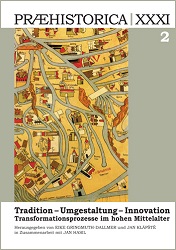Wirtschaftshöfe auswärtiger Zisterzienserklöster in Mecklenburg und der Landesausbau im 13. Jahrhundert
Outlying Granges of Cistercian Monasteries in Mecklenburg and Medieval Settlement Colonisation (13th century)
Author(s): Winfried SchichSubject(s): Architecture, History of Church(es), Social history, 13th to 14th Centuries, Sociology of Religion
Published by: Univerzita Karlova v Praze, Nakladatelství Karolinum
Keywords: Mecklenburg; Middle Ages; medieval settlement colonisation; Cistercians; outlying granges; lay-brothers; monastic buildings;
Summary/Abstract: Cistercian monasteries, located in the northern German region of Holstein (Rheinfeld), on the lower Rhine (Altenkamp), in the Weser Mountains (Amelungsborn) or on the fringes of the Harz Mountains (Michaelstein) were in possession of granges (monastic estates) in the 13th century. These granges were lived in and run by monks and lay-brothers of the Cistercian Order. The Cistercians engaged in a variety of ways in the transformation processes that shaped Mecklenburg in the medieval period. They organized forest-clearances and set up new villages. The lay-brothers jointly with those people living as dependents on the monastic estates participated actively in the cultivation of the land. The newly established monasteries were entitled to force the inhabitants of former villages to resettle if it was seen to be in the interest of the newly established granges. The economic success of two of those, Satow and Rosin, is reflected in the establishment of ‘urban farms’ in towns closest to them, in Rostock and Güstrow respectively, for the storage and marketing of their products.
Journal: Praehistorica
- Issue Year: 31/2013
- Issue No: 2
- Page Range: 149-165
- Page Count: 17
- Language: German

